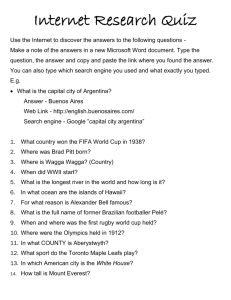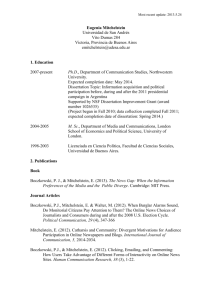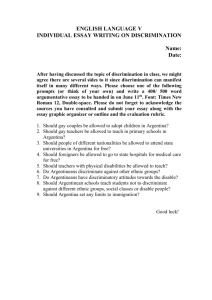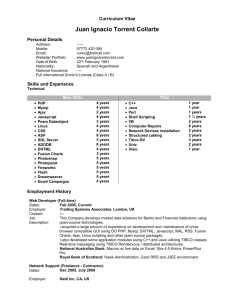מצגת של PowerPoint
advertisement
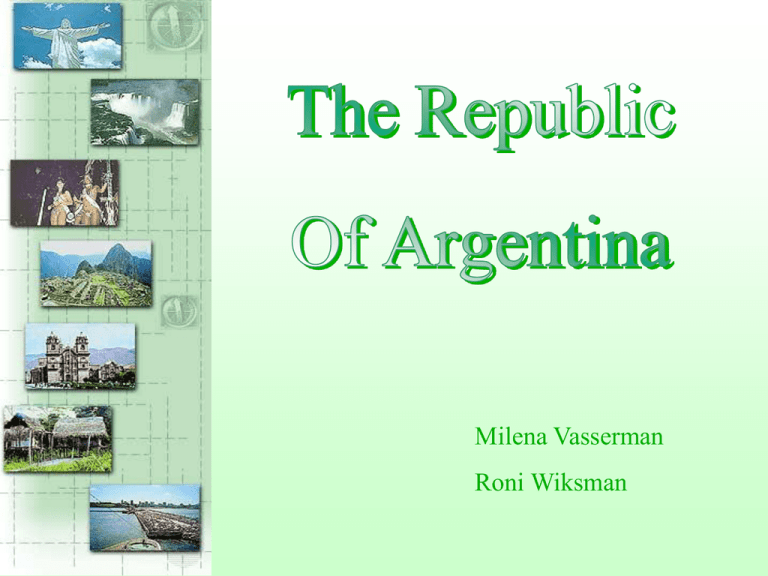
Milena Vasserman Roni Wiksman The flag of Argentina The capital city of Argentina is The people in Argentina speak 93% Catholics 2.5% Protestants Back continuation 2% Jewish Back continuation Holidays from the Catholic calendar May 25 - Anniversary of the First National June 20 - Day of the Flag July 9 - Independence Day August 17 - Anniversary of the Death of General October 12 - Columbus Day Government José de San Martín The favorite food of the people of Argentina is The most important contribution of the popular culture of Argentina to the world is A very romantic and dramatic dance Argentina is a republic. The president of Argentina is Fernando Da La Roe In Argentina there are four areas with different climate: In the north the weather is sub-tropical. The areas in the east and the center of the country (The Pampas) are cooler and get a lot of water. The west areas are dry. In the south of the country (Patagonia), the climate is cold and very dry. The Pampas are Argentina's agricultural heart. This is the home of one of the most famous symbols of Argentina, the cowboys (gaucho). In the area, there are many kinds of different views, such as: forests, hills, grasslands and salt lakes. Some of the most important cities in the area are: Rosario, Santa Fe, La Plata and Luján (In the church of this city visit 4 million visitors every year). Back to map continuation The largest city in Argentina. 40% of the Argentinean population lives in the city of Buenos Aires' and it’s suburbs. Buenos Aires' attractions: The Catedral Metropolitana - which contains the tomb of José de San Martín, a hero of Argentina's struggle for independence The Teatro Colón - the building in which opera, ballet and concerts of classical music take place. Many popular museums, including the Museo Nacional de Bellas Artes, Museo del Cine and Museo Histórico Nacional. Back to map continuation In the summer, many Argentineans go to the beach. Mar del Plata is one of the most popular cities located on the northern Atlantic coast, 400km from the capital. Beaches in this area are very beautiful and many hotels are located near the sea. The tourists can enjoy watching the Sea lions resting on the beach. Back to map continuation Argentina's second city. For many years there was a great competition between Córdoba and Buenos Aires. In Cordoba there are many interesting buildings, such as the Iglesia Catedral and the Iglesia de la Compañía and one of the most important historical museums in the country (The Museo Histórico Provincial Marqués de Sobremonte). Back to map continuation The people who lived in Argentina originally were Indian. The first white people who came to the country were Spanish, and they were looking for gold. After few years they built the city Buenos Aires, but the Indians attacked them and they had to leave the place. Only in 1580 they could build the city again. In the beginning of the 19th century the British were fighting against Spain and tried to attack Buenos Aires. But they didn’t succeed. In 1810 the Argentineans began their revolution against Spain and in 1817 they got their independence. The leader of this revolution was José de San Martín . In 1943 there was a military revolution and Juan Peron became the leader of the country, until there was another military revolution in 1955. Peron returned to Argentina again in 1973. When he died, in 1974, his second wife Isabel became the president. Between the years 1976 and 1983 the country was under a very cruel military government, and many people who were against the government “disappeared”. In 1982 Argentina fought against Britain in the Falkland Islands (The Malvunas), but lost the war. After the war the military government fell. Today Argentina is enjoying the freedom of democracy. The tango is a very emotional and dramatic dance, that was born in Buenos Aires in the 19th century. In the 1920s and 1930s, the singer Carlos Gardel made the tango famous around the world. The instruments used to play tango music are: the bandoneón (similar to an accordion), the violin and the guitar. Outside Buenos Aires, other dances are popular, such as the Escondido - the dance of the gauchos. Jorge Luis Borges (1899-1986) is the most famous writer in Argentina. He wrote short stories. One of his stories, “Kiss of the Spider Woman”, became a famous film. Argentina's national sport game is fútbol (soccer). The Argentinian national team has become one of the best in the world and won World Cup in 1978 and 1986.


